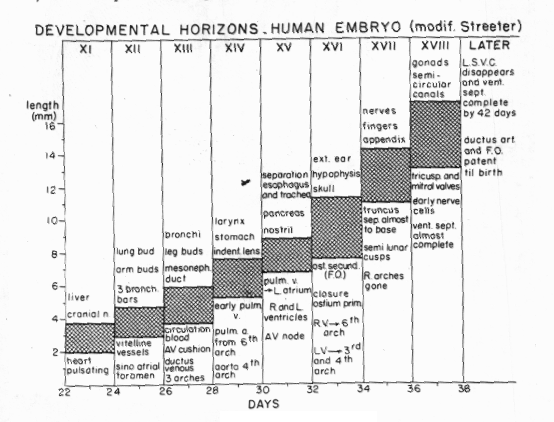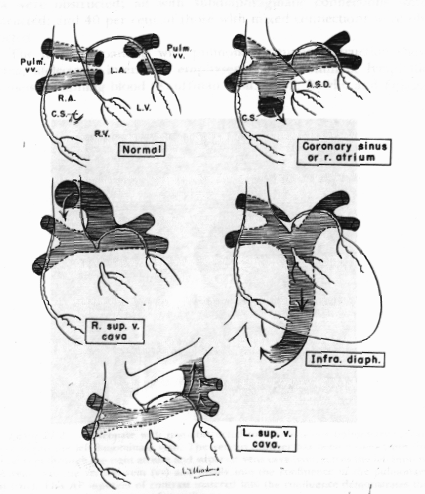Development of the Pulmonary Veins in the Human Embryo

Total Anomalous Pulmonary Venous Return or TAPVR is a congenital heart defect where the pulmonary veins do not connect to their normal point of attachment which is the left atrium of the heart. Instead the pulmonary veins connect to the right atrium or to other parts of the venous system. TAPVR is not a problem during fetal development in utero because of high pulmonary vascular resistance and because the foramen ovale is open between the atria and shunts the circulating blood thus, bypassing the pulmonary system. At birth the pulmonary vascular resistance decreases and the foramen ovale may close causing blood flow to increase to the right heart and lungs. Cyanosis and congestive heart failure result. If the TAPVR is not surgically corrected death within the first year of life is likely.

Between Horizons XII and XVI of human embryo development the heart divides into four chambers and the common pulmonary vein, the lung bud and pulmonary circulation develop. The pulmonary veins mainly develop during Horizons XIII and XV which corresponds to Days 26 to 32 of human embryo growth. During Horizon XV the pulmonary veins are very close to the right and left horns of the sinus venosus. Thus, a small shift in position of the pulmonary veins during development can lead to the veins connecting to the right horn of the sinus venosus instead of the left horn. This may be the stage of development where TAPVR can arise. However, the mechanism of the development of the pulmonary veins is still controversial and so, this theory is speculative.

The normal figure illustrates the pulmunary veins attaching to the left atrium.
These four anomalies are:
1.Drainage into the Right Atrium
The pulmonary veins may attach to the right atrium if the atrial septum develops too far to the left.
2.Drainage into the Right Common Cardinal System
The pulmonary veins may connect to the right superior vena cava.
3.Drainage into the Left Common Cardinal System
The pulmonary veins may connect with the left superior vena cava.
4.Drainage into the Umbilicovitelline System
The pulmonary veins may connect to the portal vein or ductus venosus via a channel associated with the esophagus.
Most cases of TAPVR are not due to familial links. However, several familial cases have been reported and studied. The two predominant theories about the genetic mechanism of inheritance are that TAPVR is either multifactorially determined or is an autosomal dominant disease with incomplete penetrance and variable expressivity. Also a gene for familial TAPVR has been linked to chromosome 4p13-q12. Further studies are underway to further define the gene's chromosomal location.
There are two great websites that are specific to TAPVR.
-The University of Utah Perinatal Genetics Research Lab of the Department of Obstetrics and Gynecology
-Congenital Heart Disease on the World Wide Web
References and the sources of diagrams for this site include:
-Neill, C.A. Development of the pulmonary veins. Pediatrics 18:880-887 (1956).
-Rowe D., Freedom R., Mehrizi A., and Bloom K. Total anomalous pulmonary venous drainage. In "The Neonate with congenital heart disease," Philadelphia W.B. Saunders Company, pp.350-372 (1981).
-as well as the two web sites listed above.